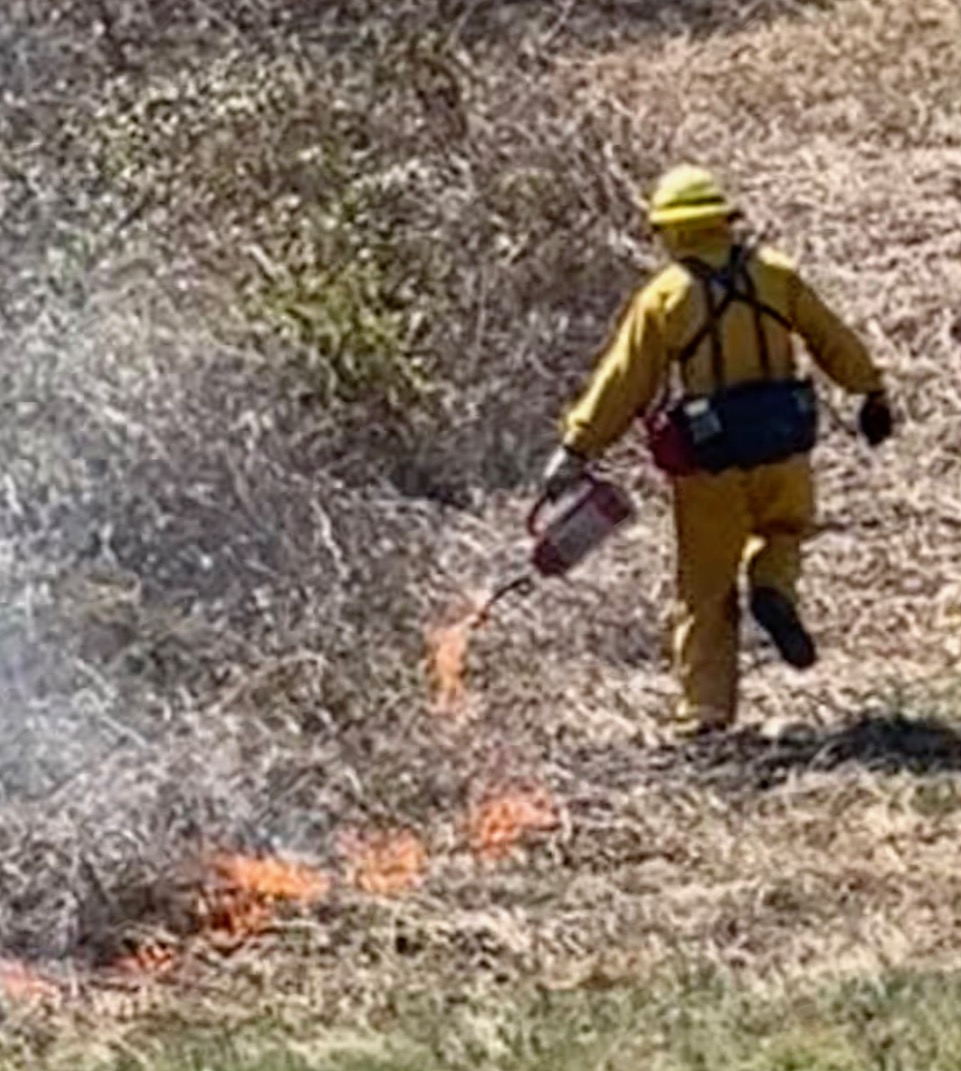The Park Authority’s natural resources branch manager John Burke explained the key reasons managed burns are needed. “They help reduce the fuel loads of grasses or woody debris in the event of unplanned fires,” he said. Prescribed fires burn at very low intensity compared to wildfires that burn out of control. The controlled burn consumed a significant amount of plant material and debris that accumulated over time from the dense presence of invasive vines.
“Prescribed fires also ‘knock back’ woody vines, shrubs, and invasive trees that would turn into woods, and then forest, which are more costly to remove in order to create better [natural] resource areas,” Burke added. “Fire can be used to control some invasive species and promote fire adaptive native ones.” This burn aims to “reduce the abundance and dominance of invasive plants, especially Porcelain Berry and Japanese Honeysuckle vines, Callery pear and Tree-of-Heaven trees. These plants have overwhelmed the other vegetation and reduced the biological diversity of plants native to Virginia.” 
Tree-of-Heaven is a target of county-wide control efforts as a host of the Spotted Lantern Fly, a non-native moth that is highly destructive to crops and has recently been found in other Virginia locations. Tall fescue, a standard livestock pasture grass imported from Europe, was grown here when the Lorton Prison maintained cows and a dairy operation. The county’s burn can “reduce the vigor of tall fescue and gradually allow native Virginia grasses and wildflowers to return to the area.”
A controlled fire event in an area of several acres lasts an entire day and takes considerable preparation. Team and equipment staging near the area on Thursday began about three hours before the first fire was lit. Fire manager, Owen Thomas Williams, a county staff ecologist, spent several more hours preparing before the day. The area was mapped to illustrate the fire plan, surveyed for hazards, and tested for any leaks along the incorporated underground natural gas lines of three providers. Fiber optic utilities and others, such as the nearby Covanta waste-to-energy facility, were notified. The county also notified park users, including biking, equestrian and volunteer groups. Prior notifications and permit approvals included local county fire and rescue stations, the fire marshal's office, and the department of forestry. Trail entrances were marked as closed and the team was instructed to stop igniting if hikers wandered past closure signs into the area, until they could be escorted out. The fire team included members of the park authority staff from several sections, trained and tapped to assist, and help from a contracted professional prescribed fire services provider. After the elaborate prep of equipment, radios, and safety gear, and a review of the plan and safety contingencies, the dozen fire team members ignited, managed, and monitored the fire, finishing late in the afternoon.
The fire team sought an “aggressive ignition” to tackle this first time burn of bare tall fescue and vines growing low to the ground. A light breeze stoked the flames which produced considerable smoke, contained within the bowl shape of the meadow, wedged between biking/hiking trails. The fire team did not leave until all fire was extinguished. Trails were immediately reopened after the fire event.
What will happen next to the area? The county describes this effort as “a preliminary measure to gauge the response of the field. During 2023, plant and animal surveys will take place to determine the results of the burn.” Ecologist Williams expects the area to regenerate naturally from the endemic seed bank present in the soil. He describes the soil as “the best possible source for native plants and biodiversity,” adding “ that seed bank represents the endemic genetic identity of the local plant community and the natural heritage of Virginia.” He expects the field to have a better chance of reviving those native seeds now with the space the fire has provided, and with relief from the dominance of non-native plant species.
How long will it take the area to recover? The day following the managed fire, the air carried an acrid tang as a pair of Ospreys called to each other while soaring over the blackened field. No doubt they were hoping to find field mice creeping out of their burrows to inspect the change to their surroundings, with fewer places to hide. The bright red of Cardinal plumage struck a brilliant contrast against the charcoaled soil, as the several pairs that frequent this meadow flew about. With Spring arriving next week, and nudged by the warmth of the fire, seeds will be sprouting soon, giving park users the opportunity to watch native plants reborn and flourishing in their renewed environment.
Thomas expects the regrowth “to begin in just two or three weeks and be highly vigorous”. How much regrowth will be native versus non-native will soon be seen. If the native plants recover well, that vegetation also will promote a more healthy and thriving ecosystem that can include native wildlife and pollinators that want to call this habitat home.
The county’s Natural Resources Branch has conducted past controlled burns this season at Riverbed, Poplar Ford, Lake Fairfax and Laurel Hill parks. Six more burns are planned for this season. More information about these efforts can be found at www.fairfaxcounty.gov/parks/nature/prescribed-burn
